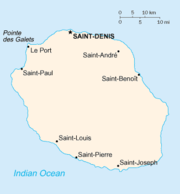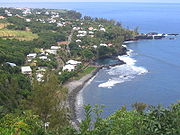
Réunion
Background to the schools Wikipedia
The articles in this Schools selection have been arranged by curriculum topic thanks to SOS Children volunteers. With SOS Children you can choose to sponsor children in over a hundred countries
| Réunion | |||
|---|---|---|---|
| — Overseas region of France — | |||
|
|||
| Country | |||
| Prefecture | Saint-Denis, Réunion | ||
| Departments | 1 | ||
| Government | |||
| • President | Didier Robert ( UMP) | ||
| Area | |||
| • Total | 2,512 km2 (970 sq mi) | ||
| Population (2009) | |||
| • Total | 827,000 | ||
| • Density | 330/km2 (850/sq mi) | ||
| Time zone | RET ( UTC+04) | ||
| GDP/ Nominal | € 14.7 billion (2008) | ||
| NUTS Region | FR9 | ||
Réunion (French: La Réunion, IPA: [la ʁeynjɔ̃]; previously Île Bourbon) is a French island with a population of about 800,000 located in the Indian Ocean, east of Madagascar, about 200 kilometres (120 mi) south west of Mauritius, the nearest island. Since August 2010, the Pitons, Cirques and Remparts of the island, covering more than 40% of its territory, feature on UNESCO's World Heritage List.
Administratively, Réunion is one of the overseas départements of France. Like the other overseas departments, Réunion is also one of the 26 regions of France (being an overseas region) and an integral part of the Republic with the same status as those situated on the European mainland.
Réunion is an outermost region of the European Union and, as an overseas department of France, is part of the Eurozone.
History
Swahili and Arab sailors formerly called the island Dina Morgabin (“The Western Island”). The Portuguese are thought to have been the first European visitors, finding it uninhabited in 1635, and naming it after Saint Apollonia.
The island was then occupied by France and administered from Port Louis, Mauritius. Although the French flag was hoisted by François Cauche in 1638, Santa Apollonia was officially claimed by Jacques Pronis of France in 1642, when he deported a dozen French mutineers to the island from Madagascar. The convicts were returned to France several years later, and in 1649, the island was named Île Bourbon after the royal house. Colonization started in 1665, when the French East India Company sent the first 20 settlers.
“Réunion” was the name given to the island in 1793 by a decree of the Convention with the fall of the House of Bourbon in France, and the name commemorates the union of revolutionaries from Marseille with the National Guard in Paris, which took place on 10 August 1792. In 1801, the island was renamed "Île Bonaparte," after Napoleon Bonaparte. The island was invaded by a Royal Navy squadron led by Commodore Josias Rowley in 1810, who used the old name of “Bourbon”. When it was restored to France by the Congress of Vienna in 1815, the island retained the name of "Bourbon" until the fall of the restored Bourbons during the French Revolution of 1848, when the island was once again given the name “Réunion”.
From the 17th to the 19th centuries, French immigration supplemented by influxes of Africans, Chinese, Malays, and Indians gave the island its ethnic mix. The opening of the Suez Canal in 1869 reduced the importance of the island as a stopover on the East Indies trade route.
During the Second World War, Réunion was under the authority of the Vichy Regime until 30 November 1942, when the island was liberated by the destroyer Léopard.
Réunion became a département d'outre-mer (overseas départment) of France on 19 March 1946. Its département code is 974.
Between 15 and 16 March 1952, Cilaos at the centre of Réunion received 1,869.9 millimetres (73.62 in) of rainfall. This is the greatest 24-hour precipitation total ever recorded on earth. The island also holds the record for most rainfall in 72 hours, 3,929 millimetres (154.7 in) at Commerson's Crater in March 2007 from Cyclone Gamede.
In 2005 and 2006, Réunion was hit by a crippling epidemic of chikungunya, a disease spread by mosquitoes. According to the BBC News, 255,000 people on Réunion had contracted the disease as of 26 April 2006. Madagascar had also been hit by this disease during the same year. A few cases also appeared in mainland France through airline travel. Then French Prime Minister Dominique de Villepin sent an emergency aid package worth 36 million Euros ($57.6M U.S. dollars) and deployed approximately five hundred French troops in an effort to eradicate mosquitoes.
Politics
Réunion sends five deputies to the French National Assembly and three senators to the Senate.
Arrondissements, cantons, and communes
Administratively, Réunion is divided into 4 arrondissements, 24 cantons, and 24 communes. It is a French overseas département as well as a French region. The low number of communes, compared to French metropolitan departments of similar size and population, is unique; most Réunionnaises communes encompass several localities, sometimes separated by significant distances. Réunion is part of the Indian Ocean Commission.
Major communities
- Saint-Benoît
- Le Port
- Le Tampon
- Saint-André
- Saint-Leu
- Saint-Denis
- Saint-Louis
- Saint-Paul
- Saint-Pierre
Geography
The island is 63 kilometres (39 mi) long; 45 kilometres (28 mi) wide; and covers 2,512 square kilometres (970 sq mi). It is similar to the island Hawaii insofar as both are located above hotspots in the Earth's crust.
The Piton de la Fournaise, a shield volcano on the eastern end of Réunion Island, rises more than 2,631 metres (8,632 ft) above sea level and is sometimes called a sister to Hawaiian volcanoes because of the similarity of climate and volcanic nature. It has erupted more than 100 times since 1640 and is under constant monitoring. It most recently erupted on 2 January 2010. Before that, the most noticeable was during April 2007, when the lava flow was estimated at 3,000,000 cubic metres (3,900,000 cu yd) per day. The Piton de la Fournaise is created by a hotspot volcano, which also created the Piton des Neiges and the islands of Mauritius and Rodrigues.
The Piton des Neiges volcano, the highest point on the island at 3,070 metres (10,070 ft) above sea level, is north west of the Piton de la Fournaise. Collapsed calderas and canyons are south west of the mountain. Like Kohala on the Big Island of Hawaii, the Piton des Neiges is extinct. Despite its name, snow (French: neige) practically never falls on the summit.
The slopes of both volcanoes are heavily forested. Cultivated land and cities like the capital city of Saint-Denis are concentrated on the surrounding coastal lowlands.
Réunion also has three calderas: the Cirque de Salazie, the Cirque de Cilaos and the Cirque de Mafate. The last is accessible only by foot or helicopter.
Economy
Sugar was traditionally the chief agricultural product and export. Tourism is now an important source of income. In 2007 the GDP of Réunion was 18.7 billion US dollars at market exchange rates. The GDP per capita was 23,501 US dollars in 2007 (at market exchange rates, not at PPP), the highest in Africa.
Demographics
Ethnic groups present include people of European, African, Malagasy, Indians and Chinese origin as well as many of mixed race. Local names for these are used: Yabs, Cafres, Malbars and Zarabes (both ethnic groups of Indian origin) and Chinois (Réunion).
It is not known exactly how many people there are of each ethnicity since there is a ban on ethnic censuses in France, which applies in Réunion because it is a part of the 1958 constitution. According to estimates, whites make up approximately one-quarter of the population, Indians make up roughly a quarter, and people of Chinese ancestry form roughly 3%. The percentages for mixed race people and those of Afro-Malagasy origins vary wildly in estimates. There are also some people of Vietnamese ancestry on the island, though they are very few in number.
People of Tamil and Gujarati origin make up the majority of the Indo-Réunionnais people; Bihari and other origins form the remainder of the population. The island's community of Muslims from North Western India and elsewhere is also commonly referred to as Zarab.
Creoles (a name given to those born on the island, of various ethnic origins), make up the majority of the population. Groups that are not creole include people from Metropolitan France (known as zoreils) and those from Mayotte and the Comoros.
Réunion is very similar in culture, ethnic makeup, language and traditions to Mauritius and the Seychelles. Réunion contains most of the same ethnic populations as Mauritius but in different proportions.
Historical population
| Year | Population | Year | Population | Year | Population | ||
|---|---|---|---|---|---|---|---|
| 1671 | 90 | 1830 | 101 300 | 1961 | 349 282 | ||
| 1696 | 269 | 1848 | 110 300 | 1967 | 416 525 | ||
| 1704 | 734 | 1849 | 120 900 | 1974 | 476 675 | ||
| 1713 | 1 171 | 1860 | 200 000 | 1982 | 515 814 | ||
| 1717 | 2 000 | 1870 | 212 000 | 1990 | 597 823 | ||
| 1724 | 12 550 | 1887 | 163 881 | 1999 | 706 300 | ||
| 1764 | 25 000 | 1897 | 173 192 | 2006 | 781 962 | ||
| 1777 | 35 100 | 1926 | 182 637 | 2007 | 790 500 | ||
| 1789 | 61 300 | 1946 | 241 708 | 2008 | 802 001 | ||
| 1826 | 87 100 | 1954 | 274 370 | ||||
| Official data from INSEE by census or estimate; estimates shown in italics. | |||||||
Religion
The predominant religion is Roman Catholicism with Hinduism, Islam and Buddhism also represented, among others.
Language
French is the only official language of Reunion. Although not official, Réunion Creole is also commonly spoken by the majority of the population. One can hear it in any administration or office, but education is only in French.
Tamil is taught as optional language in some schools. Due to the diverse population, other languages such as Mandarin, Hakka and Cantonese are also spoken by members of the Chinese community, but fewer people speak these languages as younger generations start to converse in French. The number of speakers of Indian languages (mostly Urdu and Gujarati) is also dropping sharply. Arabic is taught in mosques and spoken by a small community of Muslims.
Public health
In 2005/2006, Réunion experienced an epidemic of Chikungunya, a viral disease similar to dengue fever, which infected almost a third of the population. See the History section for more details.
Culture
Réunionese culture is a blend (métissage) of European, African, Indian, Chinese and insular traditions.
The most widely spoken language, Réunion Creole, derives from French. However, an official orthography has yet to be agreed upon.
Local food and music blend influences from Africa, India, China and Europe.
Environment
Wildlife
Réunion is home to a variety of birds such as the White-tailed Tropicbird (French: paille en queue. Its largest land animal is the Panther chameleon, Furcifer pardalis. Much of the West coast is ringed by coral reef which harbours, amongst other animals, sea urchins, conger eels and parrot fish. Sea turtles also visit the coastal waters.
Transportation
Roland Garros Airport, handling flights to Madagascar, Mauritius, Africa, Australia and Europe serves the island. Pierrefonds Airport, a smaller airport, has some flights to Mauritius and Madagascar.








